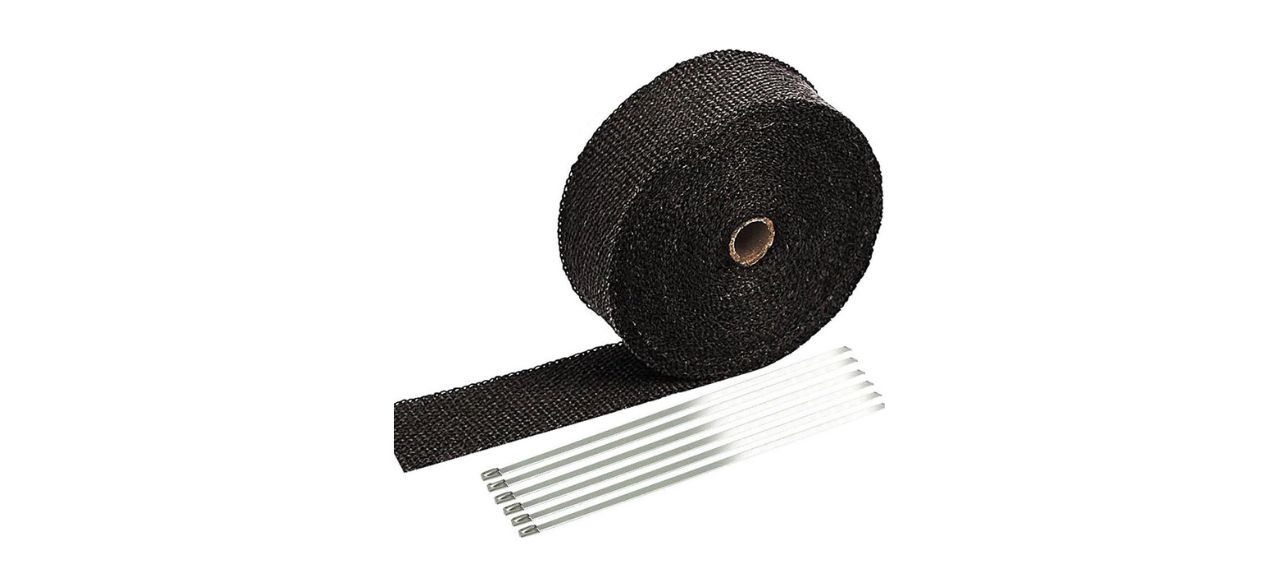For some reason, we all love to buy tech that is far too small for us. Many of us walk around with aching necks, throbbing headaches, and tingling fingers because we spend the day hunched over a laptop that was not designed to fit our body.
The crucial distance for comfort is elbows to eyeballs: While sitting up straight, your keyboard should be at (or slightly below) elbow height while the top of the screen should be at eye level. To work without pain, that’s how tall your laptop screen should be.
For most people, that would require purchasing a model that was as large as a mid-sized TV. Since enormous tech probably won’t be trending any time soon, here are a few preventative and recuperative tips to help keep you pain-free when working on that tiny laptop.
Shop this article: Upright GO Posture Device and SunplusTrade 2″ x 50′ Black Exhaust Heat Wrap Roll for Motorcycle Fiberglass Heat Shield Tape
Prevent pain from using your laptop all day
Finding the best laptop position
The biggest problem with a laptop is the position you need to be in to use it. You lean forward, curve your back, round your shoulders, and hunch over so your fingertips and eyes are only about a foot apart. Besides the pain in your neck, back, and shoulders, routinely remaining in this position for long stretches of time can lead to numerous health issues such as loss of feeling in your fingers, breathing issues, and chronic fatigue.
A laptop stand tilts your keyboard and raises your laptop so the screen is closer to your eye level. Since your hands will also be raised a little bit, it is not the perfect solution, but it is a quick, easy, and affordable way to help eliminate that hunched back position. And adding a wireless keyboard can help you achieve the proper typing angle.
How to position your desk chair
When people think about getting an ergonomic chair, they tend to focus on lumbar support. While it is extremely important to provide support to that lower section of the spine, the curved segment between the hips and the ribs, there’s another crucial area that needs just as much attention.
Believe it or not, if you’re experiencing lower back pain after working at your laptop, it could be the height of your chair that is the problem. The angle of your hips is what places pressure on your spine. If your chair is too low, your knees will be higher than your hips, which will put a great deal of pressure on your lower back — even if you are using a lumbar support. If your chair is too high, your knees will be lower than your hips, which will pull you away from the lumbar support, again placing stress on your lower back.
To help keep your lower back pain-free, when you sit in your desk chair (whether it’s ergonomic or not), make sure your knees are at the same level as your hips or just slightly lower.
How to sit while working on a laptop
Even if you have a laptop stand and your lumbar-supporting ergonomic chair is set to the right height, you still have to remember to maintain good posture.
However, as that deadline looms and you dive deeper and deeper into your work, chances are, you’re going to start to hunch over that laptop and put stress on your neck, shoulders, and back. What you need when this happens is a gentle reminder. An Upright GO posture device attaches to your back (with adhesive) and gently vibrates when you start to deviate from perfect posture. The device comes with an app that allows you to set goals so you can eventually learn how to maintain your good posture without any reminders.
Sold by Amazon
Why it’s important to stretch during work
The human body was designed to move. It doesn’t matter what position you’re in, you shouldn’t remain there for extended periods of time. Movement actually stimulates your nerves to block pain impulses and it makes you feel better. If possible, stand up, stretch, gently roll your neck, and take a brief walk around the office (or your home) every 30 minutes.
If that’s too disruptive to your workflow, aim for a break every 60 minutes. Taking those few minutes every hour can increase your productivity and help prevent those nagging aches and pains that may become chronic if you don’t take care of yourself.
Remember to hydrate
A dry sponge is crisp and can be easily broken, whereas a wet sponge is remarkably resilient. Your muscles are like sponges. To keep them pliant, you need to drink water. Consider a water filter pitcher so you can always have a fresh supply of drinking water on hand and in sight to keep your body and muscles sufficiently hydrated.
Recover from pain after using your laptop all day
Don’t worry. It happens to the best of us. Those extra few minutes here and there add up and suddenly, you’ve overdone it — you’ve stayed hunched over too long and now you’re in pain. Here are a few ways to help you mend.
Should you use ice or heat for pain relief?
SunplusTrade 2″ x 50′ Black Exhaust Heat Wrap Roll for Motorcycle Fiberglass Heat Shield Tape
Many people are not sure whether to use ice or heat for pain. In general, ice is used within the first 48 hours of an injury to reduce swelling and inflammation. The pain felt from being hunched over a laptop, however, is usually a result of sustained muscle tension. Cold can actually make this type of pain worse.
Heat, on the other hand, can dilate blood vessels and promote blood flow. It can be used to reduce muscle spasms, especially in back and neck areas, and eliminate tension headaches. Heat should never be applied directly to the skin and the temperature should never exceed 160 degrees Fahrenheit. If you are experiencing aches and pains after a day of work at your laptop, consider taking a warm soak with bath salts, using a heating pad, or applying a heat wrap to any sore areas of your body.
Sold by Amazon
How to massage away pain from sitting at a desk
If applying heat to your stiff and sore areas isn’t as effective as you were hoping, you can step up your recuperative measures by adding massage. Besides generating heat from friction, a massage makes tight muscle fibers a little more pliable. This can relax the tension on nerve endings and relieve pain.
If you do not have a personal masseuse in your contacts, a percussion massage gun might be the best answer. This device uses heat and rapid bursts of pressure to increase blood flow and reduce muscle tension.
If you’d like another option, a foam roller can provide similar relief. This cylindrical massage device targets key trigger points in your muscles to stimulate blood, oxygen, and lymphatic circulation. It is important to point out that using a foam roller (or a massage gun) may hurt a little, but that just means it’s doing its job. The relief that you feel after you’ve finished a session will be worth it.
Stretches for desk workers
Regular stretching not only relieves pain, but it can also extend your range of motion and make your muscles healthier and more resistant to injury. However, before grabbing your yoga mat, make sure you consult with a healthcare professional as stretching incorrectly can make your condition worse. Some basic guidelines to remember are to breathe slowly and deeply, move gently, hold your stretches steady, don’t bounce or force movements, and stop immediately if there is any pain.
Want to shop the best products at the best prices? Check out Daily Deals from BestReviews.
Sign up here to receive the BestReviews weekly newsletter for useful advice on new products and noteworthy deals.
Allen Foster is a writer for BestReviews. BestReviews is a product review company with a singular mission: to help simplify your purchasing decisions and save you time and money.
BestReviews spends thousands of hours researching, analyzing and testing products to recommend the best picks for most consumers.
Copyright 2023 BestReviews, a Nexstar company. All rights reserved.



















